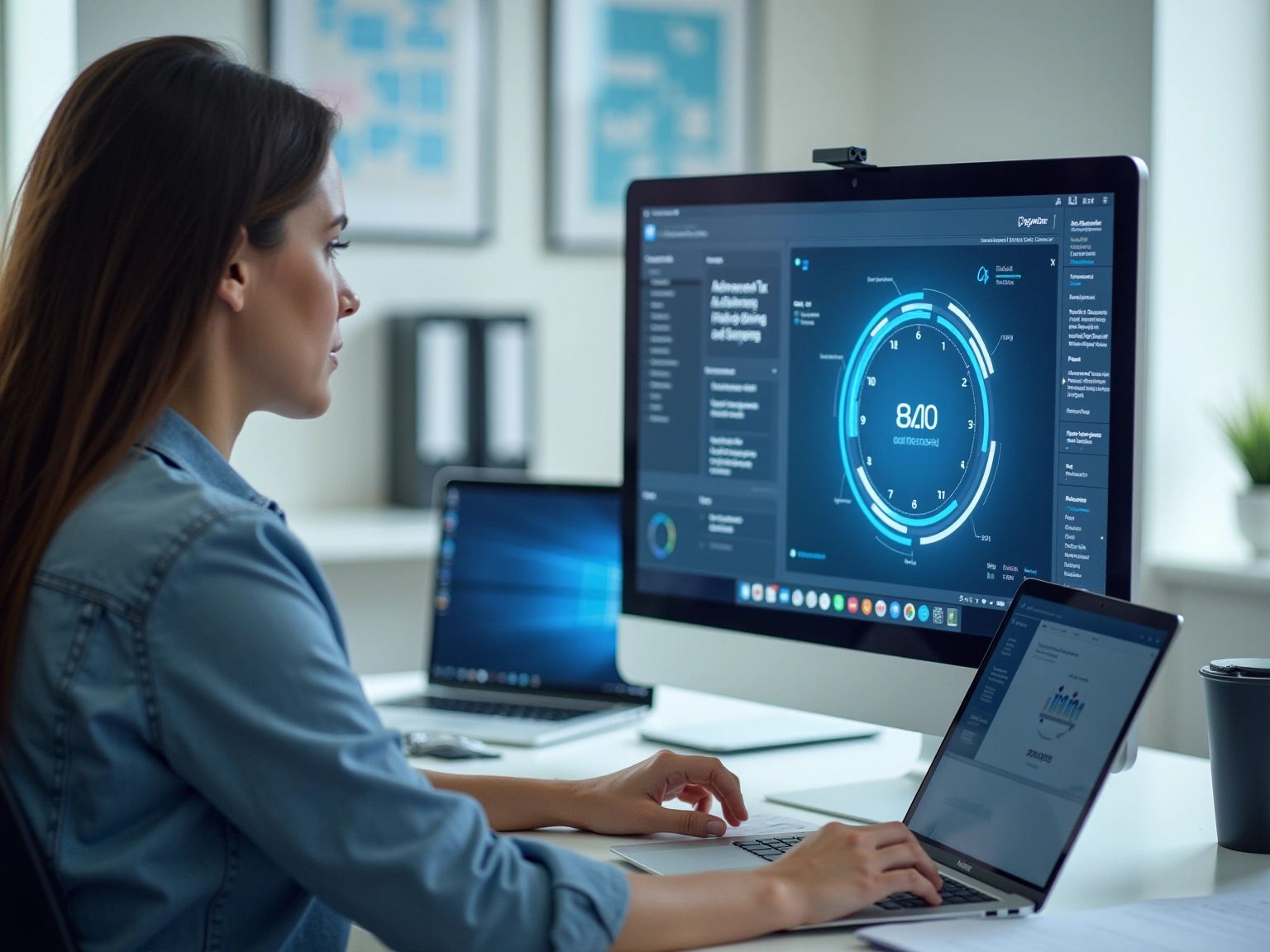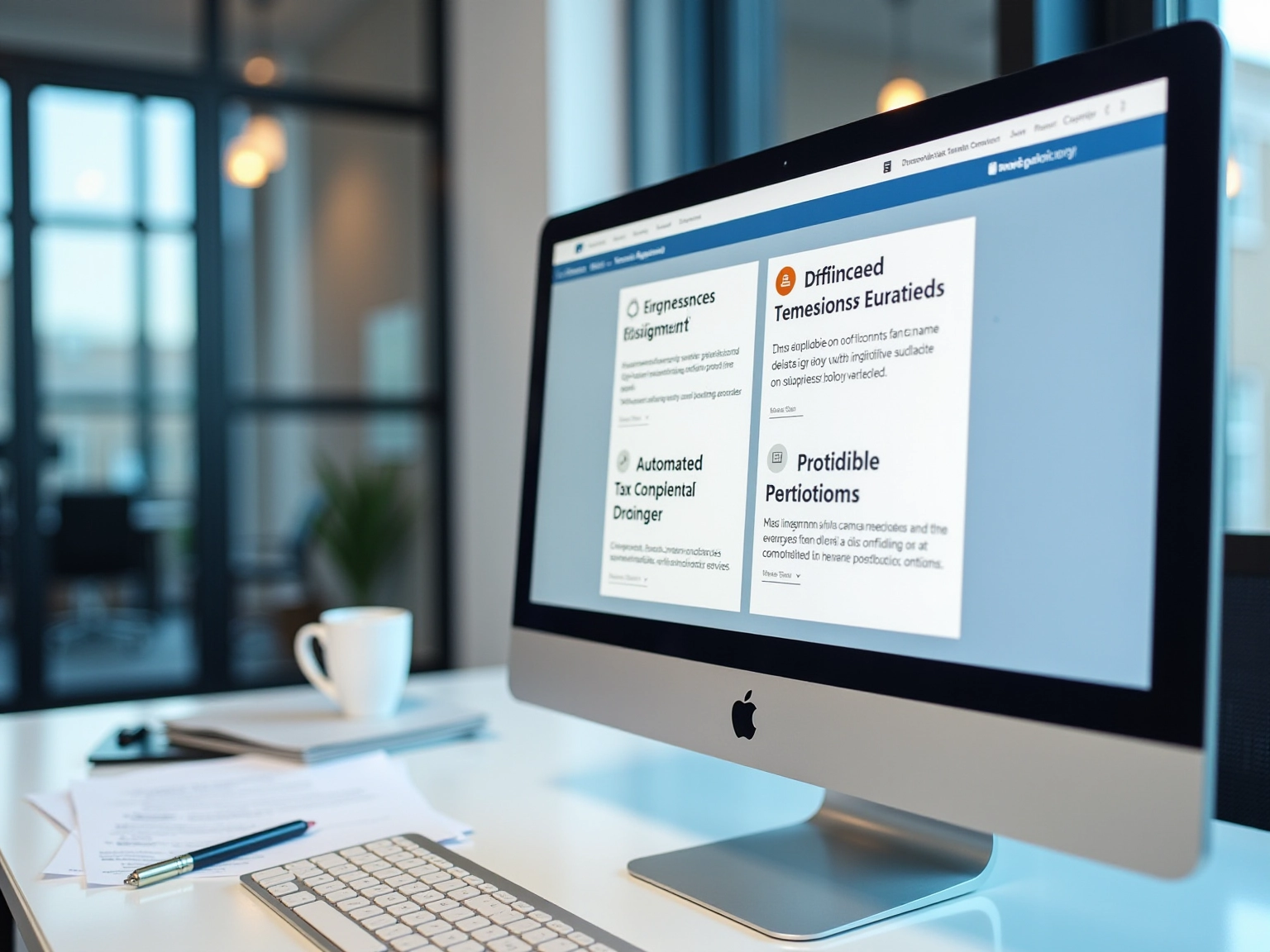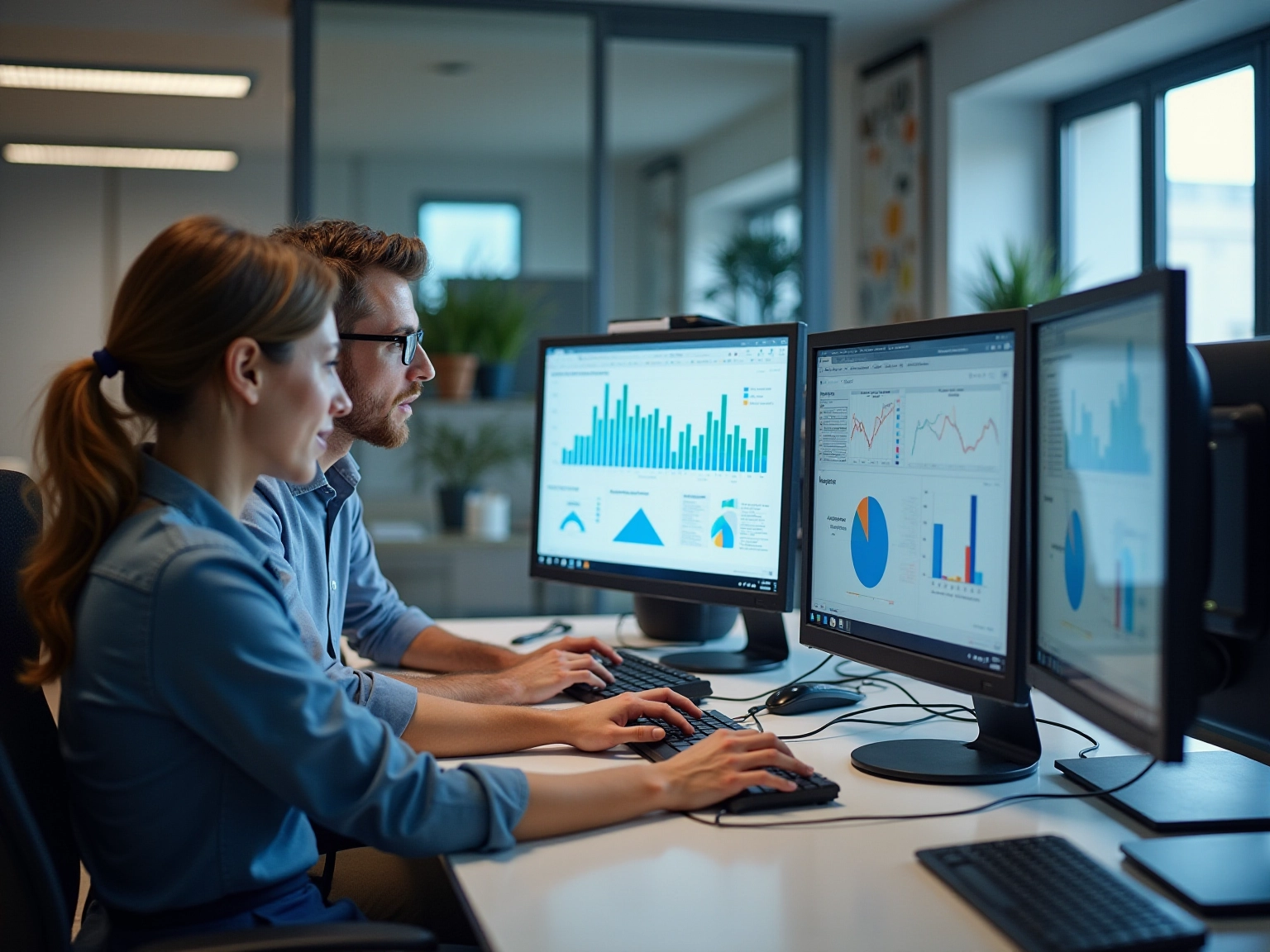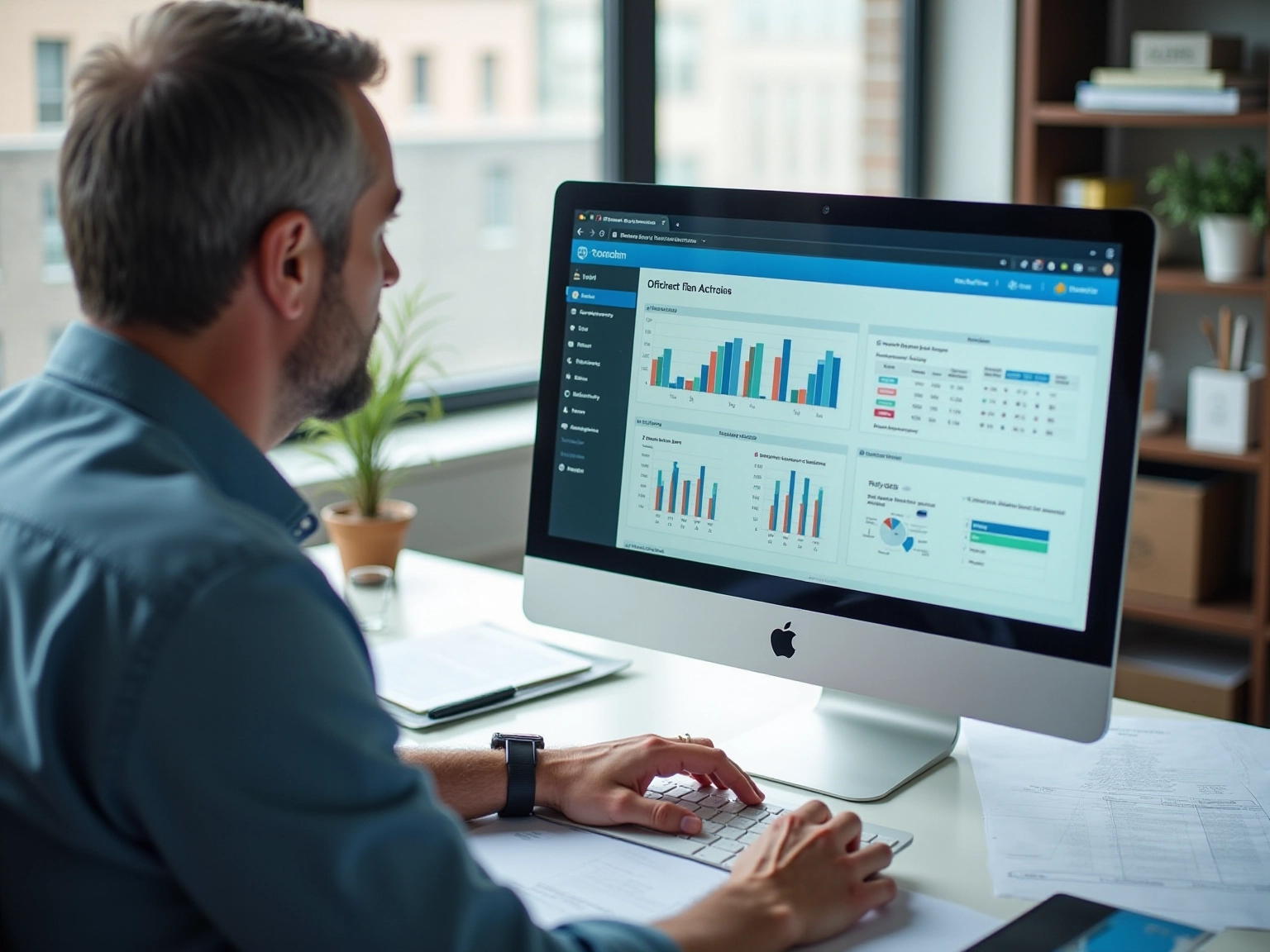Overview
This article provides a comprehensive comparison of various tax software options available for tax professionals, meticulously examining their features, benefits, and costs. It highlights the critical role these tools play in enhancing both efficiency and accuracy in tax preparation.
Selecting the right software is paramount; therefore, it is essential to evaluate key features such as:
- Automation
- Compliance updates
- Pricing models
As these factors significantly influence productivity and client satisfaction. User testimonials further underscore this, with many reporting substantial time savings and improved workflows, reinforcing the necessity of making an informed choice.
Key Highlights:
- Tax software assists individuals and businesses in preparing and filing tax returns, automating calculations and ensuring compliance with tax laws.
- The shift to digital tax solutions has increased efficiency, with tax professionals reporting significant time savings and improved client interactions.
- Cloud-based tax applications enable remote work, real-time collaboration, and automatic updates, enhancing the overall tax preparation process.
- Key features to consider in tax software include user interface, automation, compliance updates, customer support, integration capabilities, security, and cost.
- Automated processes can save tax professionals up to 40% of their time, while also increasing accuracy and customer satisfaction.
- Different pricing models for tax software include subscription-based, one-time purchase, tiered pricing, and free trials, impacting budget and functionality.
- User testimonials indicate substantial time savings and improved efficiency, with some reporting up to 288 hours saved in a single tax season.
- Selecting the right tax software involves evaluating its features, pricing, and user feedback to ensure it meets both operational needs and client expectations.
Introduction
In the rapidly evolving world of accounting, tax software has emerged as a critical tool for professionals seeking to navigate the complexities of tax preparation and compliance. These digital solutions are not merely a luxury; they are a necessity in today’s competitive landscape. With features designed to streamline workflows, enhance accuracy, and foster better client relationships, tax software addresses the pressing challenges faced by accounting managers. As tax regulations grow increasingly intricate and the demand for efficiency escalates, understanding the various types of tax software available—ranging from personal to business solutions—becomes paramount. This article delves into the key features, benefits, and cost considerations of tax software, equipping professionals with the insights needed to make informed decisions that can significantly impact their practice and client satisfaction.
Understanding Tax Software: An Overview
Tax programmes represent a vital suite of applications designed to assist individuals and businesses in efficiently preparing and filing their tax returns. These tools automate complex calculations, ensure compliance with ever-evolving tax laws, and frequently feature capabilities for tracking expenses and income. As tax regulations become increasingly intricate, the reliance on tax software for tax professionals has surged, establishing it as an essential resource for those aiming to streamline workflows and mitigate the risk of errors.
In 2025, a substantial percentage of tax professionals transitioned to tax software tailored for their needs, reflecting a broader trend towards digital solutions that enhance accessibility and collaboration. This shift facilitates real time updates and data sharing, enabling seamless communication between accountants and their clients, ultimately boosting overall efficiency. Notably, companies utilising platforms like Glasscubes have reported an impressive 50% reduction in response times and a 40% increase in customer interaction, underscoring the advantages of contemporary tax applications in enhancing customer engagement.
The evolution of tax applications is marked by a transition from traditional desktop programmes to more versatile cloud-based solutions. This shift empowers tax professionals to work remotely and collaborate more effectively with clients through specialised tax software, fostering a dynamic and responsive approach to tax preparation. Recent innovations in tax applications have introduced features such as automated reminders and real time reporting, which are crucial for managing customer interactions and ensuring prompt responses.
The company, in particular, offers specialised onboarding support that significantly enhances user information collection and engagement, further elevating the overall experience.
Expert insights underscore the importance of tax software for tax professionals in modern accounting practises. Numerous experts acknowledge that such software not only enhances productivity but also greatly improves customer satisfaction. For instance, companies that have adopted innovative solutions have experienced a 40% increase in client response rates, highlighting the tangible benefits of integrating technology into tax preparation.
Users like Sophie Montgomery from TaxAssist Accountants have reported saving an astounding 288 hours in a single tax season, thanks to the streamlined processes enabled by these tools.
As the landscape of tax applications continues to evolve, it is clear that investing in advanced tax software for tax professionals, such as Glasscubes, is crucial for enhancing service delivery and operational efficiency.

Types of Tax Software: Personal vs. Business Solutions
Tax applications can be categorised into two main types: personal and business solutions, each tailored to meet specific needs. Personal tax applications cater to individual taxpayers, focusing on features such as simple income reporting, deductions, and credits. Popular choices like TurboTax and H&R Block excel in managing straightforward tax scenarios, making them user-friendly for individuals with basic tax requirements.
Conversely, business tax applications are specifically designed for companies, offering advanced features that encompass payroll management, multi-user access, and compliance with corporate tax regulations. Solutions such as TaxCalc and Taxfiler are favoured among accountants and businesses for their robust capabilities, effectively addressing the complexities of corporate tax scenarios. Notably, companies utilising Glasscubes, a tool created for UK accountants, reported a remarkable 50% decrease in customer response times and a substantial 40% increase in customer interaction.
This underscores the effectiveness that specialised business tax applications can provide, particularly in optimising audit and accounts management.
Recognising these differences is crucial for tax professionals when selecting suitable tax software for their clients. While personal tax applications may suffice for individual taxpayers, businesses often require tax software to navigate intricate tax obligations efficiently, equipped with comprehensive features. As Sophie Montgomery from TaxAssist Accountants highlighted, utilising such applications can lead to significant time savings, with an impressive 288 hours saved in just one tax season.
This knowledge not only aids in optimising customer service but also enhances overall operational efficiency within accounting practises. Furthermore, the secure, user-friendly platform improves communication and simplifies information collection through features like automated reminders and real-time visibility, emphasising the importance of selecting the right application for diverse user requirements. Unlike conventional email communication, which can lead to lost or overlooked replies, this platform ensures that all correspondence is organised and readily accessible, providing reassurance for both companies and clients.

Key Features of Tax Software: What to Look For
When evaluating tax software for tax professionals, prioritising essential features is crucial, as they can significantly enhance efficiency and effectiveness.
- User Interface: A user-friendly interface is paramount; it drastically reduces the learning curve and boosts overall productivity. Recent statistics reveal that a well-designed user interface can lead to a 30% increase in user satisfaction, making it a vital consideration for accountants. The platform offers a customisable interface that can be branded with your company logo and colours, ensuring a seamless experience for users.
- Automation: Automation features, such as automated reminders and scheduled requests, are invaluable for saving time and minimising errors. In 2025, automation is projected to reduce tax preparation processing times by up to 50%, allowing accountants to focus on more strategic tasks. Automated reminders can assist in pursuing clients for essential documents, simplifying the engagement process.
- Compliance Updates: Regular updates reflecting changes in tax laws are essential for ensuring compliance. Tax software that offers timely updates helps avoid costly errors and ensures adherence to regulations. The company is ISO 27001 and GDPR compliant, confirming that your data management practises meet the highest standards.
- Customer Support: Reliable customer support is critical, especially during the high-pressure tax season. Access to knowledgeable support can significantly impact the resolution of issues quickly and efficiently. The company provides a dedicated customer success manager to assist with onboarding, ensuring that users can maximise the software’s potential from the outset. Additionally, various support packages, including Bronze, Silver, and Gold, cater to different needs.
- Integration Capabilities: The ability to seamlessly integrate with other accounting tools enhances workflow efficiency. The platform features an open API for seamless integration into your systems, enabling a more unified approach to customer management.
- Security Features: Given the sensitivity of tax data, robust security measures are non-negotiable. Effective tax applications should include advanced encryption and secure data management practises to protect client information from breaches. The company guarantees that data is fully encrypted during transmission and while stored, providing reassurance for accountants managing sensitive information.
- Cost: Ultimately, the expense of tax applications is a significant factor. The company offers various pricing plans, starting at £120 per month for essential features, providing a comparative perspective for accounting managers assessing options.
Additional features in Glasscubes, such as digital file approval for client document approvals like end-of-year accounts and task management for tracking and creating tasks, collectively contribute to a more streamlined and effective tax preparation process. This enables accountants to leverage tax software for tax professionals to deliver superior service to their clients.

Benefits of Tax Software: Enhancing Efficiency and Accuracy
The adoption of tax applications offers a multitude of advantages for tax professionals in 2025.
Time Savings: Automating repetitive tasks through tax software enables professionals to focus on more complex issues, significantly reducing the time required for tax preparation. Tax professionals have reported average time savings of up to 40%, allowing for more effective resource allocation. Notably, 54% of accountants are directing their investments towards AI, automation tools, and machine learning, reflecting a strong trend towards automation in the industry. The platform enhances this by allowing audit managers to request information effortlessly, carrying it forward annually, which further simplifies the process.
Increased Accuracy: Automated calculations drastically reduce the likelihood of human error, resulting in more precise tax filings. This improvement in accuracy is crucial, especially as 98% of accountants have noted the impact of rising costs and high interest rates on their operations, making attention to detail vital. Furthermore, firms utilising automated solutions like Glasscubes have experienced significant reductions in operational costs, validating the financial benefits of such tools.
Improved Customer Satisfaction: The combination of quicker turnaround times and precise filings fosters increased trust and satisfaction among customers. More than 7 in 10 (78%) tax professionals have reported expanding their customer lists in the past year, with an average increase of 31%, highlighting the positive impact of efficient service delivery. Glasscubes contributes to this by offering customers transparency; they can see what information is still outstanding, enhancing their engagement and satisfaction. Additionally, 94% of respondents agree that soft skills are crucial for accountants, underscoring the importance of maintaining a human touch in client interactions.
Streamlined Workflows: Tax applications often integrate seamlessly with other accounting tools, facilitating smoother workflows. Features such as document sharing and real-time collaboration enhance communication and efficiency, allowing teams to work more cohesively. As emphasised by case studies, identifying and monitoring key metrics is essential for enhancing accounts payable efficiency, which is also relevant to tax application usage. Automated reminders and real-time reporting features further streamline these workflows, ensuring that all parties are aligned and informed.
Cost-Effectiveness: While initial expenses may be associated with adopting tax applications, the long-term savings in time and reduced errors typically outweigh these investments. Glasscubes offers various pricing plans:
- The Essential plan at £120 per month
- The Professional plan at £180 per month
- The Advantage plan at £360 per month
User licence fees range from £18 to £38. Overall, tax software for tax professionals is revolutionising the operational landscape, making processes not only more efficient but also more effective. As companies embrace these technologies, they report significant enhancements in both precision and client satisfaction, emphasising the transformative potential of tax tools in the accounting sector. Moreover, the platform ensures data security with ISO27001 compliance and encryption, addressing critical concerns for accountants regarding data safety.

Cost Analysis: Evaluating the Price of Tax Software
When evaluating tax software for tax professionals, it is crucial to consider the various pricing structures available, as these can significantly impact both budget and functionality. Key models include:
- Subscription-Based Pricing: Many cloud-based solutions operate on a subscription model, providing flexibility and continuous updates. This approach allows users to access the latest features without incurring additional costs for upgrades, making it a popular choice among modern accounting firms. For instance, companies utilising the platform have experienced a 40% rise in client response rates and a 50% decrease in response times, illustrating the efficacy of subscription-based solutions in improving client engagement. Glasscubes offers tailored support packages, including Bronze (£1,500 p.a.), Silver (£4,500 p.a.), and Gold plans, ensuring that firms can select a level of service that aligns with their operational needs and budget. Each plan includes features such as a 99.9% uptime guarantee, guaranteed response times of less than 24 hours for Bronze, less than 6 hours for Silver, and less than 1 hour for Gold, along with email support, online chat support, and phone support (subject to fair usage policy).
- One-Time Purchase: Traditional applications often require a one-time investment, which may appear cost-effective initially. However, this model can lead to unforeseen expenses for updates and ongoing support, potentially increasing the total cost of ownership over time.
- Tiered Pricing: Certain service providers implement tiered pricing structures, offering multiple plans based on features and capabilities. Glasscubes exemplifies this with its Bronze, Silver, and Gold plans, allowing users to select a plan that aligns with their specific needs and budget, ensuring they only pay for the functionalities they require. This tiered pricing model can be advantageous for firms aiming to enhance their technology investment while addressing specific operational needs.
- Free Trials: A significant number of tax programme providers offer free trials, enabling professionals to assess the programme’s capabilities before making a financial commitment. This practise is widespread, with statistics showing that more than 60% of providers of tax software for tax professionals offer free trial options, allowing users to evaluate usability and features directly. Assessing these pricing models concerning the features provided is essential for making an informed choice about which tax solution delivers the best value for money. For instance, accountants often weigh the cost against features, with many noting that subscription-based models can lead to better long-term savings due to their comprehensive support and regular updates. Sophie Montgomery from TaxAssist Accountants reported an impressive 288 hours saved in just one tax season utilising the platform, underscoring the practical benefits of efficient technological solutions. Furthermore, the onboarding support and workflow effectiveness offered by platforms such as Glasscubes are crucial elements to evaluate when determining the overall worth of tax solutions.
Traditional vs. Cloud Tax Software: A Comparative Analysis
When selecting between traditional and cloud tax applications, several critical factors come into play:
- Accessibility: Cloud software offers unparalleled access from any device with internet connectivity. This capability enables accountants to work remotely and collaborate seamlessly. Platforms like Glasscubes specifically tackle missed communications and delayed responses, thereby improving accessibility for accountants and their clients. With automated reminders and organised responses, Glasscubes ensures that no information is misplaced, allowing for a more streamlined engagement process.
- Updates: One of the significant advantages of cloud solutions is their automatic updates, which ensure compliance with the latest tax laws and regulations. Conversely, traditional software typically requires manual updates, which can lead to potential compliance risks if not managed diligently.
- Collaboration: Cloud-based platforms excel in facilitating real-time cooperation among team members and stakeholders. This enhanced communication streamlines the tax preparation process, allowing for quicker responses and more efficient workflows. For instance, companies utilising Glasscubes have reported a 40% rise in customer response rates, demonstrating the effectiveness of cloud solutions in promoting collaboration. Additionally, the platform provides a real-time, visual progress report, enabling accountants to track outstanding requests and queries effortlessly. This functionality significantly aids in decreasing response times and improves overall customer engagement.
- Cost Structure: Traditional applications often entail a higher upfront cost, which can be a barrier for many firms. In contrast, cloud solutions generally offer flexible subscription pricing, making them more accessible for a wider range of accounting professionals. This adaptability can lead to significant cost savings over time, especially when considering the time saved through efficient information gathering and communication.
- Data Security: While both traditional and cloud applications can be secure, cloud solutions like Glasscubes frequently incorporate advanced security measures, including regular backups, encryption, and GDPR compliance, to protect sensitive client data. This is especially vital in the accounting sector, where data integrity is essential. Ultimately, the choice between traditional and cloud tax applications depends on the particular needs and preferences of the tax expert regarding tax software for tax professionals. As the cloud computing market continues to expand, with a projected CAGR of 17.43% until 2032, the benefits of cloud tax applications are becoming increasingly evident. Notably, users such as Sophie Montgomery from TaxAssist Accountants have reported remarkable time savings, including one individual saving an impressive 288 hours in a single tax season, further emphasising the effectiveness of cloud solutions.
User Experiences: Testimonials and Case Studies
User experiences with tax software reveal significant variations in efficiency and effectiveness, with numerous testimonials underscoring the transformative impact of these tools:
- Sophie Montgomery, TaxAssist Accountants: “By utilising the platform, we saved 288 hours in a single tax season, greatly enhancing our efficiency and customer response rates.” This impressive time efficiency demonstrates how the platform, utilising tax software for tax professionals, improves client engagement and simplifies information collection, resulting in a 50% decrease in client response times.
- Steve, Audit Manager at MGI: “Prior to utilising the platform, we encountered difficulties with lengthy email exchanges and misplaced information, which rendered the audit process unwieldy.” However, the platform has assisted significantly with the entire audit process. Customers appreciate the clarity to understand precisely what details they still need to submit. Instead of repeatedly inquiring with us, they can simply log in to the platform and view this on their own. We’ve discovered that customers upload information faster than they typically would through email, which has greatly aided our audit team. We sense that we’re receiving faster replies from customers by requesting information through the platform instead of our previous method using emails. Furthermore, the company offered outstanding assistance throughout the setup procedure, guaranteeing a seamless transition for our team and customers. This emphasises how Glasscubes enhances customer interaction and simplifies information collection for accountants.
- John Smith, Small Business Owner: “Switching to TurboTax allowed me to file my taxes in half the time compared to previous years, and the automated reminders kept me on track.” This highlights the effectiveness of TurboTax in simplifying the tax filing process, making it a popular choice among users seeking efficiency.
- Emily Johnson, CPA: “The integration of H&R Block with my accounting application streamlined my workflow, making it simpler to manage customer information and submissions.” This integration showcases how H&R Block enhances productivity for accounting professionals by facilitating seamless data management.
These testimonials collectively highlight the significant time savings and efficiency enhancements that tax software for tax professionals can provide, benefiting both individual users and accounting firms alike. The experiences shared by users reflect a broader trend in the industry, where the adoption of tax software for tax professionals is increasingly recognised as essential for optimising workflows and enhancing client satisfaction.
Furthermore, as emphasised by ‘This Commission’, quality assurance should accompany any initiatives to broaden service coverage, highlighting the significance of quality in technological solutions. Additionally, the case study of Zakladni Skola As Hlavkova’s administrative improvement with Microsoft 365 Copilot illustrates the significant impact of technology on efficiency, paralleling the benefits that Glasscubes offers to accounting firms.
Making an Informed Choice in Tax Software
Selecting the right tax software for tax professionals demands a thorough evaluation of several critical factors, including the type of programme (personal versus business), essential features, pricing models, and user feedback. Tax specialists must focus on utilising tax software that not only enhances efficiency and accuracy but also elevates customer satisfaction while remaining budget-conscious. By 2025, a significant proportion of tax experts are prioritising efficiency in their software selections, reflecting a broader trend toward optimising workflows within the accounting sector.
In assessing various options, it is vital to consider their strengths and weaknesses in relation to specific operational needs and client demands. For example, the recent reform of the non-domicile tax regime in the UK, effective April 2025, highlights the necessity for flexible systems capable of adapting to evolving tax regulations. This reform is projected to generate an average of £3.1 billion annually from 2026-27 to 2028-29, underscoring the importance of compliance and precise reporting in the choice of tax software.
Moreover, as private investments in AI projects are anticipated to reach $200 billion globally by 2025, the integration of advanced technology into tax software can significantly enhance functionality and user experience. The expected average expenditure per worker in the SaaS market is also set to rise to $108.70 in 2025, indicating a growing investment in solutions that deliver tangible benefits. Additionally, with inflation projected to decline to the 2 percent target by the second quarter of 2024, the economic landscape may further influence decisions regarding tax software, emphasising the need for accounting managers to seek cost-effective solutions. Real-world examples illustrate how tax professionals are evaluating their software choices.
For instance, companies that have adopted innovative tools report substantial time savings—one user noted an impressive 288 hours saved in a single tax season. Before leveraging the platform, many faced challenges with lengthy email exchanges and lost information during client interactions, which hindered productivity. By streamlining information collection, the platform has transformed the way companies engage with clients, leading to faster, higher-quality responses and improved workflow efficiency.
These testimonials underscore the importance of selecting tax software that not only meets current needs but also anticipates future challenges in the tax landscape.
In conclusion, making informed decisions in the selection of tax software involves evaluating efficiency, adaptability, and user experience, ensuring that the chosen solution aligns with both professional goals and client expectations. Discover how Glasscubes can further enhance your customer engagement—watch our on-demand demo to see how we streamline information gathering and eliminate workload bottlenecks. Join firms like Menzies that have experienced a 40% improvement in client response times.

Conclusion
Tax software has become an indispensable asset for accounting professionals navigating the complexities of tax preparation and compliance. The significant advancements in tax software are particularly evident in the shift from traditional desktop applications to cloud-based solutions. This transition enhances accessibility and collaboration, streamlining workflows and ultimately improving efficiency and client satisfaction. As demonstrated through various case studies, tools like Glasscubes have proven effective in reducing response times and increasing client engagement, showcasing the tangible benefits of adopting modern tax software.
Moreover, understanding the differences between personal and business tax software is crucial for making informed decisions tailored to specific needs. The key features—user interface, automation, compliance updates, customer support, integration capabilities, security measures, and cost—are essential considerations that can significantly impact the effectiveness of tax preparation processes. As firms increasingly prioritise efficiency and accuracy, the integration of advanced technology in tax software is becoming a vital factor in enhancing operational practises.
Ultimately, the choice of tax software should be guided by an evaluation of its features, pricing models, and user feedback, ensuring alignment with both professional goals and client expectations. Investing in the right tax software not only streamlines workflows but also fosters better client relationships, paving the way for sustained success in the dynamic landscape of accounting. Embracing these digital solutions is not just a trend; it is a critical step toward optimising service delivery and achieving long-term operational efficiency.
